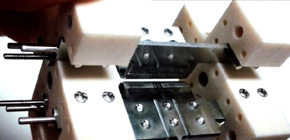
Expect new quantum information and basic physics experiments using extreme quantum state control
Succeeded in observing quantum overlap in a simple system
A group of researchers led by URABE Shinji (Professor, Graduate School of Engineering Science, Osaka University) and SHIKANO Yutaka (Specially Appointed Associate Professor, Research Center of Integrative Molecular Systems, Institute for Molecular Science, National Institutes of Natural Sciences; Visiting Assistant Professor, Institute for Quantum Studies, Chapman University) created a micron-sized quantum tunneling rotor, thereby succeeding in observing the Aharonov-Bohm (AB) effect of tunneling particles.
Quantum information technology is expected to enable difficult computation and simulation based on the basic principle of quantum mechanics. In working with one of the prospective methods, ion trap research was conducted.
NOGUCHI Atsushi , one of the researchers in this group, found that the triangular structure of the ions could be cooled to the level of the motional ground state through laser irradiation. Two-dimensional ionic structures were already known, but cooling them to the motional ground state was considered very hard. Therefore, quantum information processing research has been conducted using one-dimensional ion chains. This group succeeded in achieving quantum rotors transferred by quantum tunnelling effect between two stable orientations referred to here as 'up' and 'down', by dropping the kinetic energy of the triangular structure of the ions to the level of nanokelvin temperatures through use of adiabatic cooling.
By using the property of interference fringes, this group observed AB effect in which there is an electromagnetic potential in a region between the two paths of interferometer, even if charged particles are not directly affected by electromagnetic field, the phase difference in the form of interference fringes are produced. In experiments, this group of researchers observed the tunnelling rate theoretically predicted by AB effect changed periodically by adjusting the strength of the magnetic field.
This group succeeded in observing quantum overlap in a simple system identifiable with an optical microscope, which was quite unusual. This group's achievement will provide a new method for experiments in research on quantum simulation enabling the solving of problems which are difficult to solve with conventional computers, thereby improving quantum information technology.

Abstract
Quantum tunnelling is a common fundamental quantum mechanical phenomenon that originates from the wave-like characteristics of quantum particles. Although the quantum tunnelling effect was first observed 85 years ago, some questions regarding the dynamics of quantum tunnelling remain unresolved. Here we realize a quantum tunnelling system using two-dimensional ionic structures in a linear Paul trap. We demonstrate that the charged particles in this quantum tunnelling system are coupled to the vector potential of a magnetic field throughout the entire process, even during quantum tunnelling, as indicated by the manifestation of the Aharonov–Bohm effect in this system. The tunnelling rate of the structures periodically depends on the strength of the magnetic field, whose period is the same as the magnetic flux quantum φ0 through the rotor [(0.99±0.07) xφ0].

Figure 1

Figure 2

Figure 3
To learn more about this research, please read the full research report entitled " Aharonov–Bohm effect in the tunnelling of a quantum rotor in a linear Paul trap " at this page of the Nature Communications website.
